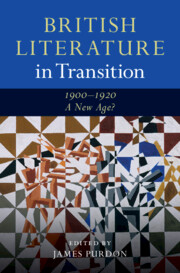Book contents
- British Literature in Transition, 1900–1920: A New Age?
- British Literature in Transition Series
- British Literature in Transition, 1900–1920: A New Age?
- Copyright page
- Contents
- Contributors
- General Editor’s Preface
- Acknowledgements
- Introduction
- Part I Nation and Empire
- Part II Media
- Chapter 7 Literature and Wartime Propaganda
- Chapter 8 Black, White, and Read All Over
- Chapter 9 Notable Trials and Literary Realism
- Chapter 10 Literature and Telecommunication
- Chapter 11 Literature and Film
- Part III Aesthetics
- Part IV Society
- Index
Chapter 8 - Black, White, and Read All Over
Mines, Mountains, and the Paysage Moralisé of the British Press*
from Part II - Media
Published online by Cambridge University Press: 07 December 2021
- British Literature in Transition, 1900–1920: A New Age?
- British Literature in Transition Series
- British Literature in Transition, 1900–1920: A New Age?
- Copyright page
- Contents
- Contributors
- General Editor’s Preface
- Acknowledgements
- Introduction
- Part I Nation and Empire
- Part II Media
- Chapter 7 Literature and Wartime Propaganda
- Chapter 8 Black, White, and Read All Over
- Chapter 9 Notable Trials and Literary Realism
- Chapter 10 Literature and Telecommunication
- Chapter 11 Literature and Film
- Part III Aesthetics
- Part IV Society
- Index
Summary
In the years 1900–20, polar exploration and high-altitude mountaineering became entrenched as features of British newspapers and the pictorial press. Meeting and propagating the appetites of an emerging audience of ‘armchair’ explorers, such publications exploited the opportunities afforded by new printing technologies to offer eye-catching typography and photographic images that conveyed the scale of Alpine adventure, and put the wastes of polar snows into the hands of the reader. Meanwhile, reporting on labour disputes connected to the British mining industry offered the yin to exploration’s icy yang: the chance to convey the greys and blacks of mines and miners through the liberal application of ink. This relationship between the black/white of the mines/snows and the black/white of the page can be seen triangulated by a further force: literary modernism’s development of a kind of spatialised moral economy. This chapter considers the tensions between a press in transition, an armchair audience in the waning days of exploration, and a body of literary work that made the most of the greyscale and the vertical axis in offering to the reader a moral and emotional landscape.
- Type
- Chapter
- Information
- British Literature in Transition, 1900–1920: A New Age? , pp. 158 - 176Publisher: Cambridge University PressPrint publication year: 2021
- 1
- Cited by

